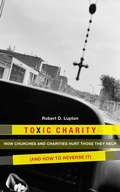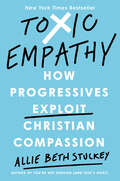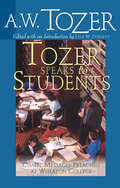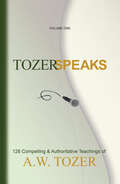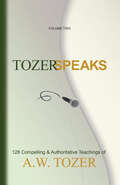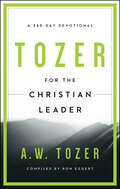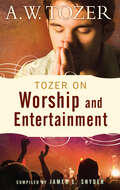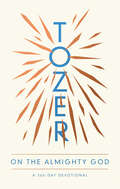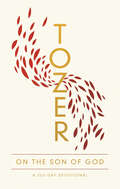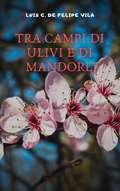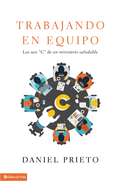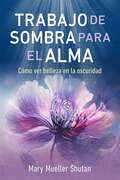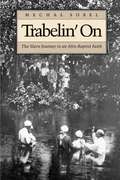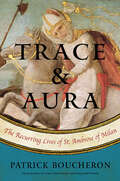- Table View
- List View
Toxic Charity: How the Church Hurts Those They Help and How to Reverse It
by Robert D. LuptonPublic service is a way of life for Americans; giving is a part of our national character. But compassionate instincts and generous spirits aren't enough, says veteran urban activist Robert D. Lupton. In this groundbreaking guide, he reveals the disturbing truth about charity: all too much of it has become toxic, devastating to the very people it's meant to help. In his four decades of urban ministry, Lupton has experienced firsthand how our good intentions can have unintended, dire consequences. Our free food and clothing distribution encourages ever-growing handout lines, diminishing the dignity of the poor while increasing their dependency. We converge on inner-city neighborhoods to plant flowers and pick up trash, battering the pride of residents who have the capacity (and responsibility) to beautify their own environment. We fly off on mission trips to poverty-stricken villages, hearts full of pity and suitcases bulging with giveaways-trips that one Nicaraguan leader describes as effective only in "turning my people into beggars." In Toxic Charity, Lupton urges individuals, churches, and organizations to step away from these spontaneous, often destructive acts of compassion toward thoughtful paths to community development. He delivers proven strategies for moving from toxic charity to transformative charity. Proposing a powerful "Oath for Compassionate Service" and spotlighting real-life examples of people serving not just with their hearts but with proven strategies and tested tactics, Lupton offers all the tools and inspiration we need to develop healthy, community-driven programs that produce deep, measurable, and lasting change. Everyone who volunteers or donates to charity needs to wrestle with this book.
Toxic Empathy: How Progressives Exploit Christian Compassion
by null Allie Beth StuckeyA sharp Christian voice makes a bold argument: when politics are driven by empathy rather than truth, innocent people pay the price. We are told that empathy is the highest virtue—the key to being a good person. Is that true? Or has “empathy,” like so many other words of our day—“tolerance,” “justice,” “acceptance”—been hijacked by bad actors who exploit compassion for their own political ends? In Toxic Empathy, Allie Beth Stuckey argues that empathy has become a tool of manipulation by left-wing activists who bully people into believing that they must adopt progressive positions to be loving. She explores the five most heated issues through which toxic empathy is deployed: abortion, gender, sexuality, immigration, and social justice. Progressives use catchy mantras to present their perspective as empathetic, like “abortion is healthcare,” “love is love,” or “no human being is illegal,” but in each case, they ignore the other side of the moral equation. For example, abortion is presented as compassionate for the woman, but what about the human life the procedure kills? This book isn’t about killing empathy; it’s about submitting our empathy to God’s definitions of love, goodness, and justice. Stuckey exposes the logical pitfalls and moral consequences of toxic empathy, equipping Christians with research-backed, Biblical truths to dismantle the progressive lies that have permeated our culture—and our church. <br><b>New York Times Bestseller</b></br>
Toxic Faith: Experiencing Healing Over Painful Spiritual Abuse
by Stephen Arterburn Jack FeltonWhen religion becomes a means to avoid or control life, it becomes toxic. Those who possess a toxic faith have stepped across the line from a balanced perspective of God to an unbalanced faith in a weak, powerless or uncaring God. They seek a God to fix every mess, prevent every hurt, and mend every conflict.<P> Toxic Faith distinguishes between a healthy faith and a misguided religiosity that traps believers in an addictive practice of religion. It shows how unbalanced ministries, misguided churches, and unscrupulous leaders can lead their followers away from God and into a desolate experience of religion that drives many to despair. Toxic Faith shows readers how to find hope for a return to genuine, healthy faith that can add meaning to life. In the words of the author, "I want to help you throw out that toxic faith and bring you back to the real thing."From the Trade Paperback edition.
Tozer Speaks to Students: Chapel Messages Preached at Wheaton College
by A. W. TozerExcept for C. S. Lewis and Oswald Chambers, it is difficult to find a 20th-century Protestant author who has a wider audience than Tozer. With more than 3 million books in print, the works of Tozer find their place on library shelves literally around the world. However, it is less well-known that Tozer had a particularly profound impact on college students. This volume consists of never-before-published chapel messages and sermons preached during 1952 and 1954 at Wheaton College. "In many ways, Tozer's messages are just as timely today as they were a generation ago," notes compiler and editor Dr. Lyle Dorsett. "The truths are timeless. It is my prayer that he will speak to you with the same life-changing power that he spoke to his generation."
Tozer Speaks to Students: Chapel Messages Preached at Wheaton College
by A. W. TozerExcept for C. S. Lewis and Oswald Chambers, it is difficult to find a 20th-century Protestant author who has a wider audience than Tozer. With more than 3 million books in print, the works of Tozer find their place on library shelves literally around the world. However, it is less well-known that Tozer had a particularly profound impact on college students. This volume consists of never-before-published chapel messages and sermons preached during 1952 and 1954 at Wheaton College. "In many ways, Tozer's messages are just as timely today as they were a generation ago," notes compiler and editor Dr. Lyle Dorsett. "The truths are timeless. It is my prayer that he will speak to you with the same life-changing power that he spoke to his generation."
Tozer Speaks: 128 Compelling & Authoritative Teachings of A.W. Tozer
by A. W. TozerTozer Speaks: Volume One is the first volume of a 2-volume set that contains compelling and authoritative teachings of A.W. Tozer in an easy to read format. A.W. Tozer's sharp and incisive preaching and writing style will startle some readers. Others will chuckle. But everyone will agree, "No one could say it like Tozer!" Contained within this gem and treasure of his work are selections from his pulpit ministry: messages on the Holy Spirit, sermons from the Gospel of John, essays on spiritual perfection, sermons in Peter's First Epistle, sermons on well-known and favorite Bible texts, sermons relating to the life and ministry of the Christian church, sermons on the voices of God and his calling of man. An unnamed layman at A.W. Tozer's Southside Alliance church in Chicago once stated, "Dr. Tozer had not been with us long before we knew we had a prophet of God in our midst. It was then that we felt constrained to begin putting his Sunday morning and evening sermons on tape."
Tozer Speaks: 128 Compelling & Authoritative Teachings of A.W. Tozer
by A. W. TozerTozer Speaks: Volume Two is the second volume of a 2-volume set that contains compelling and authoritative teachings of A.W. Tozer in an easy-to-read format. A.W. Tozer's sharp and incisive preaching and writing style will startle some readers. Others will chuckle. But everyone will agree, "No one could say it like Tozer!" Contained within this gem and treasure of his work are selections from his pulpit ministry, including sermons and messages: On the Holy Spirit, spiritual perfection, and God's calling of manFrom the Gospel of John, 1 Peter, and well-known and favorite biblical textsConcerning the life and ministry of the Christian churchAn unnamed layman at A.W. Tozer's Southside Alliance church in Chicago once stated, "Dr. Tozer had not been with us long before we knew we had a prophet of God in our midst. It was then that we felt constrained to begin putting his Sunday morning and evening sermons on tape."
Tozer Speaks: 128 Compelling & Authoritative Teachings of A.W. Tozer
by A. W. TozerTozer Speaks: Volume One is the first volume of a 2-volume set that contains compelling and authoritative teachings of A.W. Tozer in an easy to read format. A.W. Tozer's sharp and incisive preaching and writing style will startle some readers. Others will chuckle. But everyone will agree, "No one could say it like Tozer!" Contained within this gem and treasure of his work are selections from his pulpit ministry: messages on the Holy Spirit, sermons from the Gospel of John, essays on spiritual perfection, sermons in Peter's First Epistle, sermons on well-known and favorite Bible texts, sermons relating to the life and ministry of the Christian church, sermons on the voices of God and his calling of man. An unnamed layman at A.W. Tozer's Southside Alliance church in Chicago once stated, "Dr. Tozer had not been with us long before we knew we had a prophet of God in our midst. It was then that we felt constrained to begin putting his Sunday morning and evening sermons on tape."
Tozer Speaks: 128 Compelling & Authoritative Teachings of A.W. Tozer
by A. W. TozerTozer Speaks: Volume Two is the second volume of a 2-volume set that contains compelling and authoritative teachings of A.W. Tozer in an easy-to-read format. A.W. Tozer's sharp and incisive preaching and writing style will startle some readers. Others will chuckle. But everyone will agree, "No one could say it like Tozer!" Contained within this gem and treasure of his work are selections from his pulpit ministry, including sermons and messages: On the Holy Spirit, spiritual perfection, and God's calling of manFrom the Gospel of John, 1 Peter, and well-known and favorite biblical textsConcerning the life and ministry of the Christian churchAn unnamed layman at A.W. Tozer's Southside Alliance church in Chicago once stated, "Dr. Tozer had not been with us long before we knew we had a prophet of God in our midst. It was then that we felt constrained to begin putting his Sunday morning and evening sermons on tape."
Tozer for the Christian Leader: A 365-Day Devotional
by A. W. Tozer"I fear that we shall never see another Tozer. Men like him are not college-bred but Spirit-taught."—Rev. Leonard Ravenhill Great leaders are rare. Those who pray fervently, worship fully, and walk in integrity—who see God big and depend on Him humbly—are those trained in the way of power.Such was the case for A. W. Tozer, and Tozer for the Christian Leader shows you what made him exceptional. These reflections, grouped monthly by theme—like prayer, the personal life, and worship—are ideal for any Christian leader.Absorb Tozer&’s wisdom. Be marked by his conviction. Let his keen eye for spiritual things cut through pretense and show you truth. Read Tozer for the Christian Leader and discover the beating heart of uncommonly great and godly leadership.
Tozer for the Christian Leader: A 365-Day Devotional
by A. W. Tozer"I fear that we shall never see another Tozer. Men like him are not college-bred but Spirit-taught."—Rev. Leonard Ravenhill Great leaders are rare. Those who pray fervently, worship fully, and walk in integrity—who see God big and depend on Him humbly—are those trained in the way of power.Such was the case for A. W. Tozer, and Tozer for the Christian Leader shows you what made him exceptional. These reflections, grouped monthly by theme—like prayer, the personal life, and worship—are ideal for any Christian leader.Absorb Tozer&’s wisdom. Be marked by his conviction. Let his keen eye for spiritual things cut through pretense and show you truth. Read Tozer for the Christian Leader and discover the beating heart of uncommonly great and godly leadership.
Tozer on Worship and Entertainment
by A. W. Tozer"We are saved to worship God. All that Christ has done for us in the past and all that He is diong now leads to this one end." — A. W. TozerTozer had strong convictions about the subject of worship, as well as its corruption by what he called "the great god Entertainment." The excerpts in this book were carefully selected to give you a clear picture of his thoughts on both topics: Worship: Unacceptable Worship, Spiritual Concentration, The Presence of God, the Power of God, Personal Communion, Adoration, HymnsEntertainment: Evangelical Heresy, Propoganda, An Outward Shift, Modern Evangelism, Religious Activity, WorldlinessAlso included are Tozer's sermon "The Act and Object of Worship" in its entiretiy and his controversial essay "The Menace of the Religious Movie," written in the mid-1950s. You might not agree with all that Tozer says, but, as always, he draws a line in the sand and causes us to think critically about what is and isn't worship, and if what we are doing is truly worship.
Tozer on Worship and Entertainment
by A. W. Tozer"We are saved to worship God. All that Christ has done for us in the past and all that He is diong now leads to this one end." — A. W. TozerTozer had strong convictions about the subject of worship, as well as its corruption by what he called "the great god Entertainment." The excerpts in this book were carefully selected to give you a clear picture of his thoughts on both topics: Worship: Unacceptable Worship, Spiritual Concentration, The Presence of God, the Power of God, Personal Communion, Adoration, HymnsEntertainment: Evangelical Heresy, Propoganda, An Outward Shift, Modern Evangelism, Religious Activity, WorldlinessAlso included are Tozer's sermon "The Act and Object of Worship" in its entiretiy and his controversial essay "The Menace of the Religious Movie," written in the mid-1950s. You might not agree with all that Tozer says, but, as always, he draws a line in the sand and causes us to think critically about what is and isn't worship, and if what we are doing is truly worship.
Tozer on the Almighty God: A 365-Day Devotional
by A. W. TozerJoin A. W. Tozer as He Encounters God the FatherSpend a year dwelling on the awesomeness of God with A.W. Tozer. Tozer was a man who walked closely with God, who prayed often and shunned distraction so he could gaze more purely upon his Creator. In these daily meditations on Scripture, Tozer urges you to do the same. He will stir you toward humility and full surrender. He will expand your faith in a God so great that words fall short to describe Him. He will nourish you with truth.Encounter Tozer&’s heart and wisdom like never before in this newly revised edition. Continue worshipping alongside Tozer with the rest of his Trinitarian devotions: Tozer on the Son of God and Tozer on the Holy Spirit. With each page, may your heart be filled and your worship increased.
Tozer on the Almighty God: A 365-Day Devotional
by A. W. TozerJoin A. W. Tozer as He Encounters God the FatherSpend a year dwelling on the awesomeness of God with A.W. Tozer. Tozer was a man who walked closely with God, who prayed often and shunned distraction so he could gaze more purely upon his Creator. In these daily meditations on Scripture, Tozer urges you to do the same. He will stir you toward humility and full surrender. He will expand your faith in a God so great that words fall short to describe Him. He will nourish you with truth.Encounter Tozer&’s heart and wisdom like never before in this newly revised edition. Continue worshipping alongside Tozer with the rest of his Trinitarian devotions: Tozer on the Son of God and Tozer on the Holy Spirit. With each page, may your heart be filled and your worship increased.
Tozer on the Holy Spirit: A 365-Day Devotional
by A. W. TozerJoin A. W. Tozer as He Encounters the Holy SpiritSpend a year unearthing the wonder of the Holy Spirit alongside A. W. Tozer. Tozer was a man who thirsted for the Spirit of God, who prayed often and shunned distraction so that he might drink Him in more steadily. In these daily meditations on Scripture, Tozer will inspire you to do the same. According to Tozer, the Spirit is neglected by the modern church. But when believers know the Spirit—intimately and accurately—they experience freedom from stagnancy. They know power and life. This devotional explores many of the defining characteristics of the Holy Spirit. Each day stokes the believer's internal desire to hunger and thirst after the Spirit of God. Encounter Tozer&’s heart and wisdom like never before in this newly revised edition. Continue worshiping alongside Tozer with the rest of his Trinitarian devotions: Tozer on the Son of God and Tozer on the Almighty God. With each page, may your heart be filled and your worship increased.
Tozer on the Holy Spirit: A 365-Day Devotional
by A. W. TozerJoin A. W. Tozer as He Encounters the Holy SpiritSpend a year unearthing the wonder of the Holy Spirit alongside A. W. Tozer. Tozer was a man who thirsted for the Spirit of God, who prayed often and shunned distraction so that he might drink Him in more steadily. In these daily meditations on Scripture, Tozer will inspire you to do the same. According to Tozer, the Spirit is neglected by the modern church. But when believers know the Spirit—intimately and accurately—they experience freedom from stagnancy. They know power and life. This devotional explores many of the defining characteristics of the Holy Spirit. Each day stokes the believer's internal desire to hunger and thirst after the Spirit of God. Encounter Tozer&’s heart and wisdom like never before in this newly revised edition. Continue worshiping alongside Tozer with the rest of his Trinitarian devotions: Tozer on the Son of God and Tozer on the Almighty God. With each page, may your heart be filled and your worship increased.
Tozer on the Son of God: A 365-Day Devotional
by A. W. TozerJoin A. W. Tozer as He Encounters God the SonSpend a year encountering the Son of God alongside A.W. Tozer. Tozer was a man who abided deeply in Christ and shunned distraction so that he may more fully know his Savior—Jesus Christ. In this 365-day devotional, you too can intentionally pursue Christ daily. Every devotional features God&’s Word and Tozer&’s insights that invite you into greater knowledge of Jesus Christ. Encounter the character of Christ, His work on the cross, and His limitless love for you. Let the heart and wisdom of Tozer enrich your own faith and relationship with Christ. With each page, may your heart be filled and your worship increased.Tozer on the Son of God is the final installment in Tozer&’s Trinitarian devotionals. Know God the Father and God the Spirit, too, in Tozer on the Almighty God and Tozer on the Holy Spirit.
Tozer on the Son of God: A 365-Day Devotional
by A. W. TozerJoin A. W. Tozer as He Encounters God the SonSpend a year encountering the Son of God alongside A.W. Tozer. Tozer was a man who abided deeply in Christ and shunned distraction so that he may more fully know his Savior—Jesus Christ. In this 365-day devotional, you too can intentionally pursue Christ daily. Every devotional features God&’s Word and Tozer&’s insights that invite you into greater knowledge of Jesus Christ. Encounter the character of Christ, His work on the cross, and His limitless love for you. Let the heart and wisdom of Tozer enrich your own faith and relationship with Christ. With each page, may your heart be filled and your worship increased.Tozer on the Son of God is the final installment in Tozer&’s Trinitarian devotionals. Know God the Father and God the Spirit, too, in Tozer on the Almighty God and Tozer on the Holy Spirit.
Tra campi di ulivi e di mandorli
by Luis G. de Felipe VilaDue storie si sviluppano in parallelo, per poi intrecciarsi. Una parla di un marine, veterano dell'Afghanistan e dell'Iraq, che, durante la guerra, trova un antico libro in arabo. La seconda storia racconta di quel libro: cosa contengono le sue pagine, chi lo ha scritto ed i suoi possessori.
Trabajador de Luz Reiki
by Connie Dohan & Punit VasuUna guía del uso de Reiki. El libre describe una breve historia, charkas, meridianos, arua y téchinas del Reiki
Trabajando en equipo: Las seis 'C' de un ministerio saludable
by Daniel PrietoTrabajando en equipo es una guía práctica para la formación y el desarrollo de equipos de trabajo saludables en los distintos ministerios de una iglesia. Compuesto de secciones explicativas, además de secciones de trabajo en grupo. Recomendamos que la lectura de este libro se haga en grupo, especialmente, con aquellas personas que está trabajando en el ministerio. El propósito primordial de este libro es que todo el equipo escuche la voz de Dios y todos puedan bendecir enseñando y formando vidas de acuerdo a la voluntad de Dios. Las seis “C” de un ministerio saludable son: compañerismo, cooperación, coordinación, consagración, compromiso y competencia.
Trabajo de sombra para el alma: Cómo ver belleza en la oscuridad
by Mary Mueller Shutan• Explica cómo se desarrolla tu sombra y cómo tu reactividad ante personas y situaciones específicas refleja la forma en que proyectas tu sombra sobre los demás• Presenta una amplia variedad de herramientas de trabajo con la sombra, ejercicios de inteligencia emocional y prácticas de autoindagación para identificar tu sombra, además de sanar y liberar cualquier trauma relacionado con la sombra• Explora el concepto de sombras colectivas, incluidas las sombras en línea y de relaciones, y revela cómo liberarse de las proyecciones de sombrasA lo largo de nuestra vida negamos las partes de nuestro ser auténtico que nuestras familias, amigos y el mundo nos dijeron que estaban mal o no eran dignas de amor; de esta represión nace nuestra sombra. Cuando llegamos a la adultez, gran parte de nuestro ser auténtico se convierte en sombra, y ya no nos sentimos vibrantes y entusiasmados con la vida. Sin embargo, la sombra no está compuesta solo por el trauma y la oscuridad que hemos experimentado, sino también por la luz que aún no hemos absorbido.En esta guía práctica sobre el trauma, Mary Mueller Shutan aborda el trabajo profundo con la sombra y explica cómo encontrar compasión por tu lado oscuro, reconectar con las partes reprimidas y abandonadas de ti mismo, y reclamar la resiliencia y la alegría de tu yo auténtico completo. Una amplia variedad de ejercicios intuitivos, de inteligencia emocional y de autoexpresión te ayudará a identificar tus proyecciones de sombra, y te enseñarán cómo trabajar de manera segura y hábil las emociones difíciles que puedan surgir en el proceso de explorar los lugares menos iluminados de tu interior. Aprende a reconocer y liberarte de las sombras colectivas de la sociedad, como las sombras en línea o de las relaciones, para promover el bienestar personal y colectivo.Al ofrecer un proceso autodirigido para sanar el trauma y reclamar la luz eclipsada por la oscuridad, esta guía muestra cómo el trabajo con la sombra te permite ir más allá de las restricciones que te has impuesto a ti mismo y a los demás, y ver la belleza inherente en los lugares oscuros de tu alma.
Trabelin' On: The Slave Journey To An Afro-baptist Faith. Abridged Paperback
by Mechal SobelMechal Sobel's fascinating study of the religious history of slaves and free blacks in antebellum America is presented here in a compact volume without the appendixes. Sobel's central thesis is that Africans brought their world views into North America where, eventually, under the tremendous pressures and hardships of chattel slavery, they created a coherent faith that preserved and revitalized crucial African understandings and usages regarding spirit and soul-travels, while melding them with Christian understandings of Jesus and individual salvation.
Trace and Aura: The Recurring Lives of St. Ambrose of Milan
by Patrick BoucheronFrom one of the foremost medievalists of our time, a groundbreaking work on history and memory that goes well beyond the life of this influential saint. Elected bishop of Milan by popular acclaim in 374, Ambrose went on to become one of the four original Doctors of the Church. There is much more to this book, however, than the captivating story of the bishop who baptized Saint Augustine in the fourth century. Trace and Aura investigates how a crucial figure from the past can return in different guises over and over again, in a city that he inspired and shaped through his beliefs and political convictions. His recurring lives actually span more than ten centuries, from the fourth to the sixteenth. In the process of following Ambrose&’s various reincarnations, Patrick Boucheron draws compelling connections between religion, government, tyranny, the Italian commune, Milan&’s yearning for autonomy, and many other aspects of this fascinating relationship between a city and its spiritual mentor who strangely seems to resist being manipulated by the needs and ambitions of those in power.
